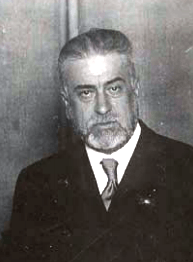Francisco Barnés Salinas facts for kids
Quick facts for kids
Francisco José Barnés Salinas
|
|
|---|---|
 |
|
| Minister of Public Instruction | |
| In office 12 June 1933 – 12 September 1933 |
|
| Preceded by | Fernando de los Ríos Urruti |
| Succeeded by | Domingo Barnés Salinas |
| Minister of Public Instruction | |
| In office 15 May 1936 – 19 July 1936 |
|
| Preceded by | Marcelino Domingo Sanjuán |
| Succeeded by | Marcelino Domingo Sanjuán |
| Minister of Public Instruction | |
| In office 19 July 1936 – 4 September 1936 |
|
| Preceded by | Marcelino Domingo Sanjuán |
| Succeeded by | Jesús Hernández Tomás |
| Personal details | |
| Born | 1877 Seville, Spain |
| Died | 1947 Mexico City, Mexico |
| Political party | PRRS (1929-1933) PRRSI (1933-1934) IR (1934-1947) |
| Occupation | Professor, politician |
Francisco José Barnés Salinas (born 1877, died 1947) was a Spanish teacher and politician. He was known for his work in education. He served as the Minister of Public Instruction and the Arts during a time called the Second Spanish Republic. After the Spanish Civil War (1936–1939), he moved to Mexico, where he lived until he died.
Contents
Early Life and Teaching Career
Francisco Barnés was born in Seville, Spain, in 1877. He went to high school and studied Philosophy and Literature in Seville.
In 1900, he became a professor at the Institute of Geography and History. He taught at schools in Pamplona and Ávila. He believed in the ideas of the Institución Libre de Enseñanza, which was a special school that promoted modern and free-thinking education.
Barnés married Dorotea González de la Calle. Her father, Urbano González Serrano, was also a famous professor. Francisco and Dorotea had several children.
In 1920, Francisco Barnés started teaching at the Instituto-Escuela. He worked there until 1936. This school had to close because of the Spanish Civil War. While teaching, he brought in many new and creative ways of teaching.
Political Career
Barnés was an active member of the Republican Left party. When the Second Spanish Republic was formed, he became a deputy in the 1931 Constituent Assembly. This assembly helped create the new government.
In 1931, he was also made a member of the Board of Trustees for the Institución Libre de Enseñanza. This board chose young teachers to go to small, faraway villages in Spain. Their goal was to introduce modern culture to the villagers in a friendly way.
Minister of Public Instruction
Francisco Barnés was appointed Minister of Public Instruction in June 1933. He served in this role from June 12, 1933, to September 12, 1933. He took over from Fernando de los Ríos Urruti. After him, his own brother, Domingo Barnés Salinas, became the minister.
During his time as minister in 1933, Barnés helped create a law. This law said that religious groups could not teach in schools anymore. Instead, new public schools were created that were not linked to religion. This idea was made a part of the country's constitution.
Barnés became Minister of Public Instruction again in May 1936. He served in the governments of Santiago Casares Quiroga and José Giral. He continued teaching at the Instituto-Escuela until his last appointment.
He was Minister of Public Instruction from May 15, 1936. For one day, on July 19, 1936, at the start of the civil war, he was replaced by Marcelino Domingo Sanjuán. But then he returned to his position. He held this role until September 4, 1936. After him, Jesús Hernández Tomás became the minister.
Later Years and Exile
After leaving his government job in September 1936, Barnés mostly stayed away from politics. He was worried about his wife and son, who were in Ávila, an area controlled by the other side in the civil war.
After his youngest son, Juan, died in battle, Barnés accepted a job as an inspector for the war front. He also went on some diplomatic missions for the government. In August 1937, he became a consul in Algiers. A year later, he became a consul in Gibraltar.
While in Gibraltar, he helped the damaged Republican ship José Luis Díez in August 1938. It was difficult to get permission from the British authorities for the sailors to leave the ship. Repairs had to be done secretly. The ship tried to escape in December 1938 but was kept in Gibraltar for the rest of the war.
After the Spanish Civil War ended, Barnés sailed from France to Mexico on a ship called the Nyassa. In Mexico, he became a professor at El Colegio de México. He also helped to create the Chapultepec Museum in Mexico City.
Francisco Barnés Salinas died in Mexico City in 1947.
See also
 In Spanish: Francisco Barnés Salinas para niños
In Spanish: Francisco Barnés Salinas para niños

